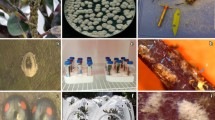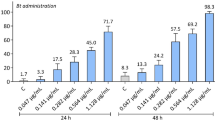Abstract
The susceptibility ofThaumetopoea wilkinsoni larvae toBacillus thuringiensis (Bt) formulations was screened in 2003 and 2004. Eggs and larvae were collected from pine forests in 11 geographical locations in Israel. Larval mortality bioassays were conducted with commercial formulations (Delfin WG, Dipel DF and Foray 48B) at concentrations ranging from 0.001% to 0.1%. Significant differences in susceptibility toBt were recorded among populations that were treated withBt intensively, frequently, or never. The mortality recorded in a population that was never treated withBt was twice that in an intensivelyBt-treated population. The correlation between susceptibility toBt and the possible resistance to the microbe is discussed.
Similar content being viewed by others
References
Battisti, A., Longo, S., Tiberi, R. and Triggiani, O. (1998) Results and perspectives in the use ofBacillus thuringiensis Berl. var.kurstaki and other pathogens againstThaumetopoea pityocampa (Den. et Schiff.) in Italy (Lep., Thaumetopoeidae).Anz. Schaedlkd. Pflanzenschutz Umweltschutz 71:72–76.
Demolin, G. and Martin, J.C. (1998) Control of pine-tree processionary caterpillar. Effectiveness and persistence of the activity of two formulations based onBacillus thuringiensis.Phytoma 507:11–14.
Farinós, G., de la Poza, M., Hernández-Crespo, P., Ortego, F. and Castañera P. (2004) Resistance monitoring of field populations of the corn borersSesamia nonagrioides andOstrinia nubilalis after 5 years of Bt maize cultivation in Spain.Entomol. Exp. Appl. 110:23–30.
Ferré, J. and van Rie, J. (2002) Biochemistry and genetics of insect resistance toBacillus thuringiensis.Annu. Rev. Entomol. 47:501–533.
Halperin, J. (1969) Prolonged pupal diapause inThaumetopoea wilkinsoni Tams.J. Appl. Entomol. 64:62–64.
Halperin, J. (1990) Life history ofThaumetopoea spp. (Lep. Thaumetopoeidae) in Israel.J. Appl. Entomol. 110:1–6.
Huchon, H. and Démolin, G. (1971) La bioécologie de la processionaire du pin. Dispersion potentielle. Dispersion actuelle.Phytoma 23:11–20.
Iqbal, M., Verkerk, R.H.J., Furlong, M.J., Ong, P.C., Rahman, S.A. and Wright, D.J. (1996) Evidence for resistance toBacillus thuringiensis (Bt) subsp.kurstaki HD-1, Bt subsp.aizawai and Abamectin in field populations ofPlutella xylostella from Malaysia.Pestic. Sci. 48:89–97.
Liu, Y.B., Tabashnik, B. and Pusztai-Carey, M. (1996) Field-evolved resistance toBacillus thuringiensis toxin CryIC in diamondback moth (Lepidoptera: Plutellidae).J. Econ. Entomol. 89:798–804.
Masutti, L. and Battisti, A. (1990)Thaumetopoea pityocampa (Den. & Schiff.): bionomics and perspectives of integrated control.J. Appl. Entomol. 110:229–234.
Moore, I., Halperin, J. and Navon, A. (1962) Laboratory and field trials in the bacterial control of the pine processionary caterpillarThaumetopoea wilkinsoni Tams withBacillus thuringiensis var.thuringiensis Berliner.Isr. J. Agric. Res. 12:167–173.
Rausell, C., Martinez-Ramirez, A.C., Garcia-Robles, I. and Real, M.D. (2000) A binding site forBacillus thuringiensis Cry1Ab toxin is lost during larval development in two forest pests.Appl. Environ. Microbiol. 66:1553–1558.
SAS Institute (2003) SAS/STAT User’s Guide for SAS. Cary, NC, USA.
Shevelev, A., Battisti, A., Volynskaya, A., Novikova, S., Kostina, L. and Zalunin, I. (2001) Susceptibility of the pine processionary caterpillarThaumetopoea pityocampa (Lepidoptera: Thaumetopoeidae) towardδ-endotoxins ofBacillus thuringiensis under laboratory conditions.Ann. Appl. Biol. 138:255–261.
Solt, I. and Mendel, Z. (2002) The pine processionary caterpillarThaumetopoea pityocampa.Harefuah 141:810–814 (Hebrew, with English abstract).
Tabashnik, B.E. and Carrière, Y. (2004) Bt transgenic crops do not have favorable effects on resistant insects.J. Insect Sci. 4:4 (published online).
Tabashnik, B.E., Cushing, N., Finson, N. and Johnson, M. (1990) Field development of resistance toBacillus thuringiensis in diamondback moth (Lepidoptera: Plutellidae).J. Econ. Entomol. 83:1671–1676.
Tabashnik, B.E., Finson, N. and Johnson, M. (1991) Managing resistance toBacillus thuringiensis: lesson from the diamondback moth (Lepidoptera: Plutellidae).J. Econ. Entomol. 84:49–55.
Author information
Authors and Affiliations
Corresponding author
Additional information
http://www.phytoparasitica.org posting Jan. 31, 2007.
Rights and permissions
About this article
Cite this article
Gindin, G., Navon, A., Saphir, N. et al. Differing susceptibility toBacillus thuringiensis formulations ofThaumetopoea wilkinsoni populations between forests with differentBt management in Israel. Phytoparasitica 35, 179–190 (2007). https://doi.org/10.1007/BF02981112
Received:
Accepted:
Issue Date:
DOI: https://doi.org/10.1007/BF02981112




